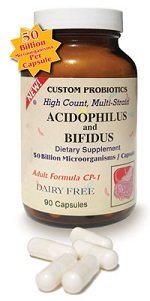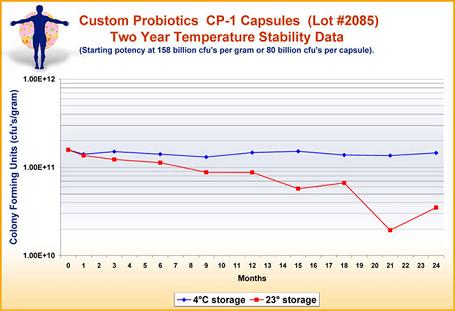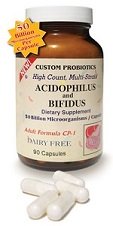- Home
- Best Probiotics
- Custom Probiotics
Custom Probiotics CP-1
Custom Probiotics CP-1 was Updated on 1/09/2025
Medically reviewed by Dr. Atmika Paudel, PhD - Written by Dan Jackowiak Nc, HHP and Dr. Vibhuti Rana, PhD
Dr. Atmika Paudel, PhD says... The properties about the bacteria in Custom Probiotics CP-1 mentioned in the article below are correct.
Custom Probiotics Adult Formula CP-1 was developed by Harry Bronozian, a chemist and a chemical engineer, who personally suffered from Helicobacter Pylori, the bacteria that causes ulcers, for 8 months and Candida for 10 years. His Candida and H. Pylori were under control within five months of regular use of his ultra-high potency probiotics and he took up to 500 billion cfus per day. In fact, an endoscopy and biopsy indicated that H. Pylori was completely eliminated from his stomach and intestine.
Custom Probiotics CP-1 is unique in the fact that it has a very high potency. Recent independent CP-1 testing has shown counts typically at 98 billion per capsule at the time of manufacture and 60 billion at expiration, which occurs in one year of manufacturing. With half of those species being three different L. acidophilus species and the other half formed by two different Bifidobacterium.
When you have been suffering from candida yeast for any length of
time and it has become chronic, you might not have any good bacteria
left. I have been told by clients, and have seen test results, that their stool tests came back
showing no L. acidophilus or Bifidobacteria!

Think about this for a minute. If you have roughly 100 trillion bacteria in your intestines, and different L. acidophilus strains make up about 20% of that, you have lost 20 trillion good bacteria. If your test comes back showing no Bifidobacteria then you have lost 65 to 70 trillion bacteria. That is 20,000 and 65,000 billion. Now do you think taking a probiotic with 1 billion live bacteria is going to do you any good? Do you think 10 billion will work?
You need to take as large a dose as you can and that dose is going to vary by individual. Even if you still have some good bacteria left in your gut, you should go for the strongest probiotic that you can so you get the most benefits from it. I'll get to how to achieve the right dose in a minute, but first I want to outline the species and what they do in Custom Probiotic Adult Formula CP-1 formula.
The Bacteria in Custom Probiotics CP-1
Lactobacillus acidophilus breaks down nutrients during
digestion and assists in the production of folic acid, niacin, and separates amino acids from bile acids which can be used again by the
body.(1)
L. acidophilus has been found to reduce the incidence of E. coli infection by 61% when it was added to cattle feed and fed to the cows.(2) It helps in reducing serum cholesterol levels and reduces the risk of heart disease in individuals with high cholesterol levels.(3)
Lactobacillus acidophilus makes up 20% of the intestinal bacteria and is also present in the vaginal environment. In both environments, it produces hydrogen peroxides that have potent bacteriostatic antibiotic properties.
It is not however, a real good candida killer; that award goes to Lactobacillus casei. Sometimes if you have too much of it in your body, it can cause acidity and cytolytic vaginosis. Cytolytic vaginosis produces symptoms just like a yeast infection, which can lead you to believe you have vaginal yeast infection when in reality you don't.
Lactobacillus Rhamnosus was originally isolated from the human intestinal tract, it belongs there like L. acidophilus does. It supports the activity of t-cells and lymphocytes, which are natural killer cells in the immune system. It is found primarily in the small intestine and stomach and smaller amounts are found in the large intestine. In the large intestine its creates a favorable environment for B. Bacterium to attach and proliferate.
It is a very strong species and can survive where most other bacterial species cannot. It has been shown to have anti-tumor activity and prevents food allergies from leaky gut syndrome. It also inhibits the growth of bad bacterial species.
Lactobacillus Plantarum was originally isolated in human
saliva. It has been found to clear up to 95% of the symptoms associated
with IBS if high enough doses are taken. It boosts immune function in
the intestine and helps with high cholesterol and heart disease. It helps to prevent C. difficule infections in those at risk when taking antibiotics.
Bifidobacteria is the most prevalent species of bacteria in the large intestine and has many substrains that we use for the natural treatment of vaginal yeast infections. CP-1 contains the two species below.
Bifidobacteria lactis has been found to stimulate the immune response in the intestine and blood. It raises t-helper cell levels and activates lymphocytes that kill fungi and yeast in the blood and intestine. The tumor killing ability of the lymphocytes and phagocytes are also increased, especially in those with poor immune function to start with.
Bifidobacteria bifidum has been found to stimulate macrophages and activate lymphocytes to produce antibodies against foreign pathogens. It also increases the production and function of t-cells and natural killer cells which suggests it has antitumor and antifungal abilities. In tests on mice, it was found to induce apoptosis in cells of colorectal cancer tumors and prevent them from spreading.
The increased immune function that these bacteria can provide helps kill your yeast overgrowth and restore intestinal pH to where it should be. Natural killer cells when functioning correctly can kill a fungal cell in 6/100th of a second. The macrophages will remove the dead waste and the good bacteria keeps the Candida from re-attaching to the intestinal wall bringing it under control.
All custom probiotics formulas do NOT contain: Dairy, sugar, gluten, soy, corn, casein, yeast, egg, artificial colors, flavors, preservatives, FOS or any Genetically Modified or engineered ingredients. They do not utilize milk, milk derivatives, galacto oligosaccharides (GOS) or inulin polysaccharides as added ingredients in the fermentation media.
Dr. Vibhuti Rana, PhD says...
The information regarding all the bacterial components of Custom Probiotics CP-1 formulae has been very elaborately covered in the above section.
The group of lactic acid bacteria have a wide commercial significance and includes many acid tolerant species such as Enterococcus, Streptococcus, and Lactobacillus (1). Lactobacillus acidophilus: Found in the oral, digestive, and vaginal tracts Lactobacillus acidophilus is quite important has a probiotic and roughly 80% of the yogurts and dairy products in the United States are supplemented with Lactobacillus acidophilus. Originally isolated from fecal samples of a healthy adult, Lactobacillus Rhamnosus by Gorbach and Goldwin (LGG) is another lactase producing species of the genus Lactobacillus that has pronounced probiotic effects (2). It aids in providing gastrointestinal benefits to the host, declining the frequencies of diarrhea; and promotes favorable immune responses. Though it has not been found effective in atopic dermatitis, its beneficial role has been found in treating eczema in newborns in prenatal (given to mother) and postnatal (given to baby) LGG-based probiotic treatment (3). Lactobacillus plantarum has also been associated with several favorable food-fermentation related properties, and is found in the human and animal oral, vaginal, and gastrointestinal mucosa (4).
Apart from the Lactobacillus species, different species of the genus Bifidobacterium have profound uses and benefits as host probiotics, especially in pathologies of leaky gut. Some of these anaerobic, gram positive species are B. adolescentis, B.lactis, and B. bifidum. It has been strongly claimed in another study that the probiotics containing Bifidobacterium species in conjunction with other species like Lactobacillus have a great potential in treating diarrhea that originates from enteric infections, and antibiotic usage, or ulcerative colitis (5,6). The role of these species has been well covered and discussed with regard to immune system modulation in the host.
- Bull M, Plummer S, Marchesi J, Mahenthiralingam E. The life history of Lactobacillus acidophilus as a probiotic: a tale of revisionary taxonomy, misidentification and commercial success. FEMS Microbiol Lett. 2013 Dec;349(2):77-87. doi: 10.1111/1574-6968.12293. Epub 2013 Oct 24. PMID: 24152174. https://pubmed.ncbi.nlm.nih.gov/24152174/
- Segers ME, Lebeer S. Towards a better understanding of Lactobacillus rhamnosus GG--host interactions. Microb Cell Fact. 2014;13 Suppl 1(Suppl 1):S7. doi:10.1186/1475-2859-13-S1-S7. https://www.ncbi.nlm.nih.gov/pmc/articles/PMC4155824/
- Kalliomäki M, Salminen S, Poussa T, Isolauri E. Probiotics during the first 7 years of life: a cumulative risk reduction of eczema in a randomized, placebo-controlled trial. J Allergy Clin Immunol. 2007 Apr;119(4):1019-21. doi: 10.1016/j.jaci.2006.12.608. Epub 2007 Feb 7. PMID: 17289135. https://pubmed.ncbi.nlm.nih.gov/17289135/
- Corsetti and Valmorri, Lactic Acid Bacteria | Lactobacillus spp.: Lactobacillus plantarum; Encyclopedia of Dairy Sciences (Second Edition); Academic Press, 2011, Pages 111-118
- Ray D, Alpini G, Glaser S. Probiotic Bifidobacterium species: potential beneficial effects in diarrheal disorders. Focus on "Probiotic Bifidobacterium species stimulate human SLC26A3 gene function and expression in intestinal epithelial cells". Am J Physiol Cell Physiol. 2014;307(12):C1081-C1083. doi:10.1152/ajpcell.00300.2014. https://www.ncbi.nlm.nih.gov/pmc/articles/PMC4269664/
- Krumbeck, J.A., Rasmussen, H.E., Hutkins, R.W. et al. Probiotic Bifidobacterium strains and galactooligosaccharides improve intestinal barrier function in obese adults but show no synergism when used together as synbiotics. Microbiome 6, 121 (2018). https://doi.org/10.1186/s40168-018-0494-4. https://microbiomejournal.biomedcentral.com/articles/10.1186/s40168-018-0494-4
Custom Probiotic CP-1 Storage Facts
Custom Probiotics CP-1 does not have to be refrigerated for up to three weeks while traveling but doing so extends the shelf life. Testing revealed virtually no difference in bacterial counts for 6 months whether refrigerated or not.
Below is a chart of custom probiotics and what happens to the amount of live bacteria when left out at room temperature.

You can see there is very little difference in the bacterial amount within the first 6 months and the chances are your going to take the whole bottle in the first month, so not refrigerating them is not required if you do not want to. Now of course this does not mean you can leave them in a hot car where it can get up to 130 degrees in the summertime.
Finding the Right Dose With Custom Probiotics CP-1
Anyone that knows anything about probiotics will tell you that you must take at least 10 billion bacteria per day if you want to achieve any kind of health benefits. This dose is for healthy individuals, not for people that suffer from yeast infections. So the dose needs to be much higher if you do have any kind of yeast infection or Candida.
If you decide to use Custom Probiotics CP-1, I suggest starting at 1 capsule two times a day for 2 days. Take with clean water, not tap water, at bedtime and in the morning on an empty stomach. After the 2 days double the dose to 2 capsules two times a day. After those 2 days raise the dose again.
At any time in this cycle of increasing dosage you may experience stomach cramping or slight constipation. This is normal because the probiotics are cleaning you out and restoring balance. It will pass so don't quit before you experience all the health benefits this natural treatment for yeast infection has to offer.
At the end of those 6 days if you are not having two bowel
movements a day or at least one good movement, increase the dose of custom probiotics by two more
capsules. Take this dose for 2 days or until you are reach the desired effect.
You keep raising the doses of custom probiotics until you do achieve at least 2 bowel movements a day, or one really good one, which usually occurs somewhere between 60 to 500 billion bacteria or 1 to 8 capsules. When this happens you have found your optimal dose for your body. Now stay on this dose until the yeast infections no longer occur. Or after a couple weeks you can slowly back off the dose to where you maintain either two bowel movements one very healthy bowel movement daily.
Note: I myself achieved two bowel movements a day when taking 2 caps in the morning and 2 caps at night.
Once your Candida yeast infection is gone and if you choose too. You can drop the dose back down to 2 or 3 capsules a day as maintenance so you never get these infections again, and to maintain balance and proper digestive function in your intestine.
Custom Probiotics CP-1 Review
These bacteria spread throughout the body as the intestinal system becomes balanced and harmful pathogens are brought under control. The intestinal ph also becomes balanced and compacted wastes are removed from the colon. In the vagina these bacteria produce hydrogen peroxides that kill yeast and other foreign pathogens that cause vaginal yeast infections, bacterial vaginosis, and urinary tract infections.
This is a good probiotic for vaginal yeast as well as intestinal. It can be used as a suppository or colonic very easily to boost bacteria levels in these areas very quickly. I would also of course take it by mouth. It is also fantastic for kids and works well to get rid of their yeast infections or for the treatment of intestinal problems.
These high doses will help get rid of your yeast infection for good. But like all other probiotics that are not grown together in their own colony, their prospects for long term survival are slim. As a matter of fact, during the manufacturing process the ability to recolonize the intestine has been stripped from all probiotic bacteria. If someone claims differently, run away very fast, they are lying to you.
Hi Dan,
Just wanted to mention that while everyone around me suffers from horrible allergies and cold -- ever since I started taking custom probiotics, I haven't had to take any allergy medication (and I only take one or two capsules a day)! YOU ARE AWESOME!
Shaily

User Rating
CP-1 is available at this website and on Amazon
Medical Review by Dr. Atmika Paudel, PhD
The properties about bacteria mentioned in the article above are correct, however, not all the strains of the bacterial species are found to have the mentioned properties. For instance; in a clinical trial study, a combination of Lactobacillus acidophilus and Bifidobacterium bifidum reduced total cholesterol level in patients with hypercholesterolemia (1).
However, it was found that certain strains of Lactobacillus acidophilus have cholesterol lowering effect in the serum, and not all strains of this bacteria have the ability to lower serum cholesterol (2). In addition, L. acidophilus has been found to help in modulating intestinal pain (3), and consumption of yogurt containing L. acidophilus was beneficial in the cases of candida vaginitis (4) as well as diabetes (5).
This is also true in the case of Lactobacillus Rhamnosus, L. Rhamnosus GG strain being the most widely studied and used in probiotics. L. Rhamnosus GG is reported to be useful in conditions such as diarrhea (6) and eczema (7). Similarly, certain strains of L. acidophilus, L. plantarum, and Bifidobacteria have found to be useful in ulcerative colitis (8). Bifidobacterium bifidum was found to show improvement in gastrointestinal cancer
(9). Although probiotic bacteria have been used without problem in several cases, its use in infants and immunocompromised conditions has been linked with risk of sepsis (10).
1. A Randomized Double-blind
Controlled Trial of Lactobacillus acidophilus Plus Bifidobacterium
bifidum versus Placebo in Patients with Hypercholesterolemia. Dr.
Sanguansak Rerksuppaphol, Department of Paediatrics, Faculty of
Medicine, Srinakhariwirot University, Nakorn Nayok-26120, Thailand. 2015
2.Assimilation
of cholesterol by Lactobacillus acidophilus. S E Gilliland, C R Nelson,
C Maxwell. Applied and Environmental Microbiology Feb 1985, 49 (2) 377-381; DOI:
3.
Rousseaux, C., Thuru, X., Gelot, A. et al. Lactobacillus acidophilus
modulates intestinal pain and induces opioid and cannabinoid receptors.
Nat Med 13, 35–37 (2007) doi:10.1038/nm1521
4. Ingestion of Yogurt Containing Lactobacillus acidophilus as Prophylaxis for Candidal Vaginitis. Annals of Internal Medicine. 1992;116:353-357.
5.
Antidiabetic effect of probiotic dahi containing Lactobacillus
acidophilus and Lactobacillus casei in high fructose fed rats.
NutritionVolume 23, Issue 1, January 2007, Pages 62-68
6.
Lactobacillus GG Administered in Oral Rehydration Solution to Children
with Acute Diarrhea: A Multicenter European Trial. Journal of Pediatric
Gastroenterology and Nutrition. 30(1):54-60, JANUARY 2000
7.
Lactobacillus rhamnosus GG in the Primary Prevention of Eczema in
Children: A Systematic Review and Meta-Analysis. Nutrients. 2018 Sep; 10(9): 1319. 2018 Sep 18. doi: 10.3390/nu10091319
8.
Systematic review of randomized controlled trials of probiotics,
prebiotics, and synbiotics in inflammatory bowel disease. 9 December 2014 Volume 2014:7 Pages 473—487 The University of Texas Medical School at Houston, Texas, USA
9.
Bahmani S, Azarpira N, Moazamian E. Anti-colon cancer activity of
Bifidobacterium metabolites on colon cancer cell line SW742. Turk J
Gastroenterol 2019; 30(9): 835-42.
10. Probiotics. V Gupta, R Garg, Department of Microbiology, GMCH, Chandigarh - 160 032, India. 4-Jul-2009
Custom Probiotics and Probiotics for Yeast Home
Any questions about Custom Probiotics Adult Formula CP-1? Feel free to contact us from the contact page of this website or see your doctor.
Article References
1. Gupta, Charu & Prof, Dhan & Gupta, Sneh. (2013). Relationships between Bioactive Food Components and their Health Benefits.
2. J Food Prot. 2007
Feb;70(2):287-91. Effect of Lactobacillus acidophilus strain NP51 on
Escherichia coil O157:H7 fecal shedding and finishing performance in
beef feedlot cattle.
3. Lang Wang, Mao-Juan Guo, Qing Gao, Jin-Feng Yang, Lin Yang, Xiao-Li Pang, Xi-Juan Jiang
Medicine (Baltimore) 2018 Feb; 97(5): e9679. Published online 2018 Feb 2. doi: 10.1097/MD.0000000000009679.
Home Privacy Policy Copyright Policy Disclosure Policy Doctors Store
Copyright © 2003 - 2025. All Rights Reserved under USC Title 17. Do not copy
content from the pages of this website without our expressed written consent.
To do so is Plagiarism, Not Fair Use, is Illegal, and a violation of the
The Digital Millennium Copyright Act of 1998.